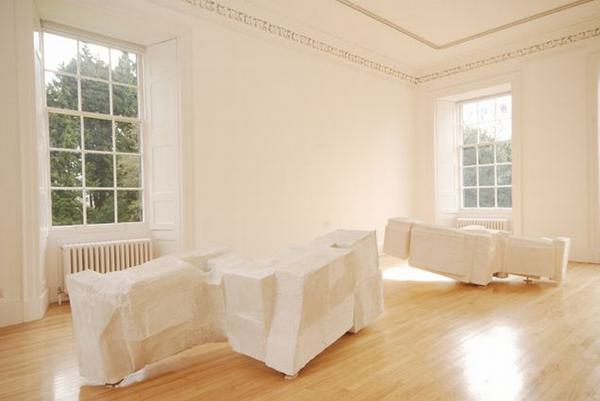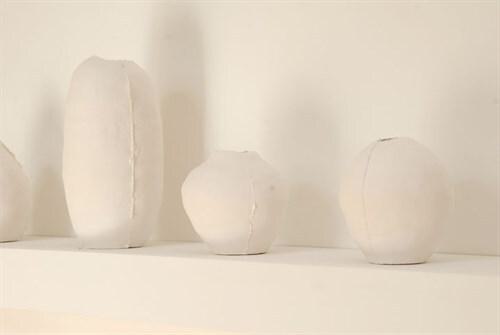Nick Evans selected by Stacy Boldrick (2011)

Nick Evans, Figures Fallen, 2008. Plaster
Stacy Boldrick of the Fruitmarket Gallery, Edinburgh profiles the work of sculptor Nick Evans
Nick Evans makes sculptures that are fleshly and inert, corporeal and otherworldly, contradictory constructions. Work such as the 'Anti Autonome' series (2010) are simultaneously abstract and figurative, although it is hard to identify what particular elements resemble: from certain perspectives, they might look like parts of human or animal bodies, tree trunks or found objects.
His work oscillates between the realms of abstraction and figuration, anthropomorphism and zoomorphism, and attends to the larger questions of the language of sculpture: about the relationships between form and material, sculpture and plinth, mass and gravity, relationships that concerned Giacometti, Arp, Moore and other Modernist artists, as well as later artists such as Nauman, Hesse and Deacon. Yet Evans maps out his own territory, bringing together translations of historic aesthetic moments with new and unexpected material forms to make work that is unnervingly dynamic and visceral.
Over the past decade Evans has been exploring the limits of what sculpture can be and what it can do. His method has involved exploiting and undermining conventional approaches to traditional materials such as plaster, bronze, wood, aluminium, terracotta and ceramic, and questioning their historic and conventional aesthetic properties and purposes. He does the same thing with newer materials such as polyester resin and fibreglass, silicone rubber and polyurethane foam.

Nick Evans, Numbers, 2008. Bone china. Installation view, Inverleith House, Edinburgh
Concerns about the history and language of sculptural materials have always been present in his work, as in the ceramic vessel/column forms of the 'Violent Femme' series (2008). Evans describes his use of forms and materials as generally interdependent.
The surface can betray the process of its making, as with 'The Numbers' (2008), bone china vessels that retain irregular mould seams. He places some works in unbelievably precarious positions, as in 'Figures Fallen' (2008). In works such as the 'Untitled' series (2009), pairs of lumpy, lumbering bronze legs advance along wooden wall mounted plinths; one work’s plinth even sprouts what could be peg legs.
Most recently, the 'Anti Autonome' series brings together organic plaster forms with tables synthesising Modernist Primitivist surface patterns and bodily forms, along with the colours and patterns of Kente cloth from Ghana and Ivory Coast, and Memphis-inspired 1980s designs. Evans makes the plaster forms by modelling sections out of clay which he then casts into plaster components.
He exploits plaster's capacity for being modelled and built up by joining the components into larger forms which consist of two or more plaster casts of the original clay sections. The aim of traditional casting is to replicate the original model in the final material. In Evans’s 'Anti Autonomes', the finished work is dictated as much by the inherent qualities and creative possibilities which arise from the ‘final’ material (plaster) as those which arise from the ‘original’ material (clay).
Evans’s work has been described in terms of hybridity and virility; corporeality and sexual energy certainly dominate the work. For Susannah Thompson '...ultimately, the immediate point to be acknowledged...is that we are looking at an orgy of breasts, phalluses, bodies...' (Exhibition text, Use History Autonome, Washington Garcia, Glasgow, 2009). For Moira Jeffrey, the work has been described as an unlikely product of copulation '...as if an exquisite piece of studio pottery by someone like Lucy Rie had accidentally mated with a dalek' ('Nick Evans: Use History Autonome', Scotland on Sunday, 22 March, 2009). No doubt it also elicits other primal responses. Perhaps his work taps into those early stages of childhood development, when we discover what makes an object a different thing to us, strange or amusing.
The psychotherapist D.W. Winnicott theorised how children, in the process of developing the ability to recognise the thing that is ‘not-me’, learn to relate to objects. He proposed that we learn to ‘destroy’ objects in our minds so that we might recover them and ‘use’ them for play (Playing and Reality 2005: 126). Not only does Evans deconstruct the conventions of sculpture, but he enables its conceptual dismantling, in a sense, its liberation from the constraints of sculpture, as well as its recovery and persistence.
Stacy Boldrick, November 2010
About Nick Evans
Nick Evans (b. 1976, Mufulira, Zambia) studied at Glasgow School of Art and the Royal College of Fine Arts, Stockholm, and lives and works in Glasgow. In 2008 he held a residency at the European Ceramic Work Centre in the Netherlands.
Selected solo exhibitions include Anti Autonome, Mary Mary, Glasgow (2010), Use History Autonome, Washington Garcia, Glasgow (2009), Primary School, Inverleith House, Edinburgh (2008), Rational Slab, Mary Mary, Glasgow (2007), Abstract Machines, Tate Gallery, St. Ives, Cornwall (2006), Some Newer Formalisms, Sorcha Dallas, Glasgow (2005), Remember Old Pineapple Face, Glasgow Project Room and Lumumba is Dead, Transmission Gallery, Glasgow (2002).
Nick Evans is represented by Mary Mary, Glasgow
About Stacy Boldrick
Stacy Boldrick is Research and Interpretation Manager at The Fruitmarket Gallery, where she is responsible for programming talks and seminars and for writing and producing interpretative materials for exhibitions.
After completing an MA at the University of Pittsburgh and a PhD in History of Art at the University of Manchester, Stacy was Research Co-ordinator for the Henry Moore Institute in Leeds, where she curated Homes for the Soul: Micro-architecture in Medieval and Contemporary Art and, with David Park and Paul Williamson, she curated Wonder: Painted Sculpture from Medieval England. From 2002 to 2007, Stacy co-ordinated research projects between institutional partners in VARIE (Visual Arts Research Institute Edinburgh) and was an occasional lecturer at the University of Edinburgh. With Richard Clay she edited Iconoclasm: Contested Objects, Contested Terms (Ashgate, 2007). Stacy is an Honorary Fellow in History of Art at the University of Edinburgh, and writes about medieval and contemporary art.
These biographies were written in (2011) as part of the Open Frequency programme. For the most current information, please visit:
Open Frequency (2004–2014)
This profile was part of Open Frequency, an Axis programme that highlighted emerging developments in contemporary art practice across the UK. Artists were selected and profiled by leading curators, artists, and writers, offering unique insights into the practices shaping contemporary art at the time. These archives remain a valuable resource for understanding the trajectory of some of the most exciting artists of the period.
Helping Artists Keep Going
Axis is an artist-led charity supporting contemporary visual artists with resources, connection, and visibility.


